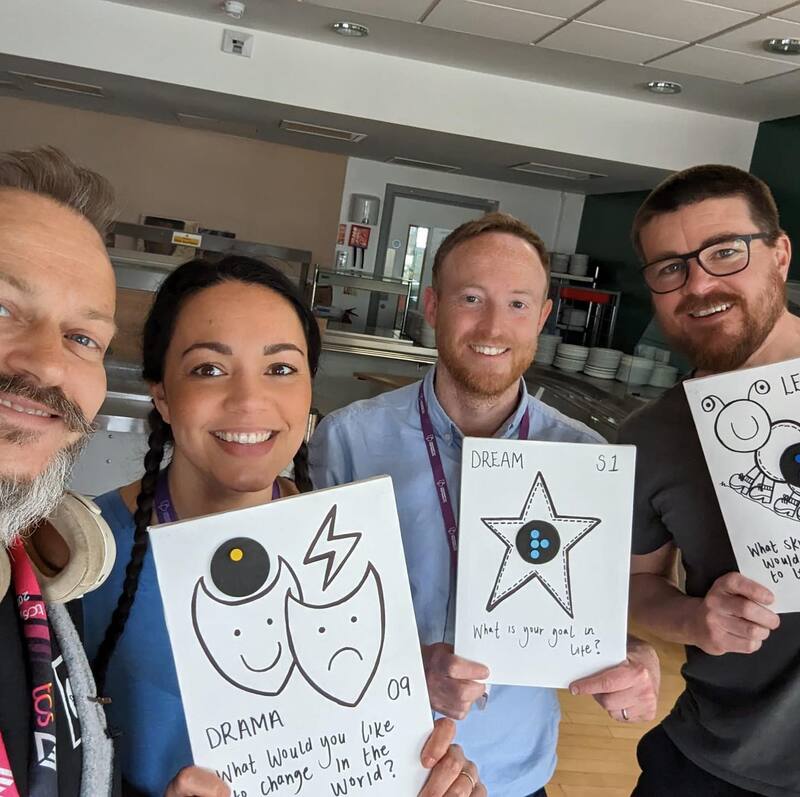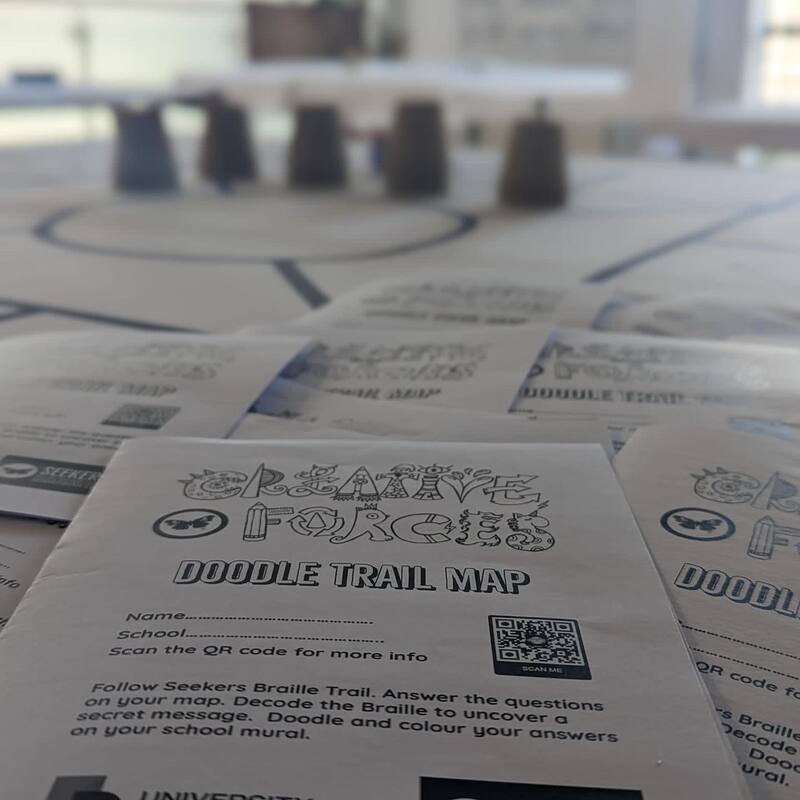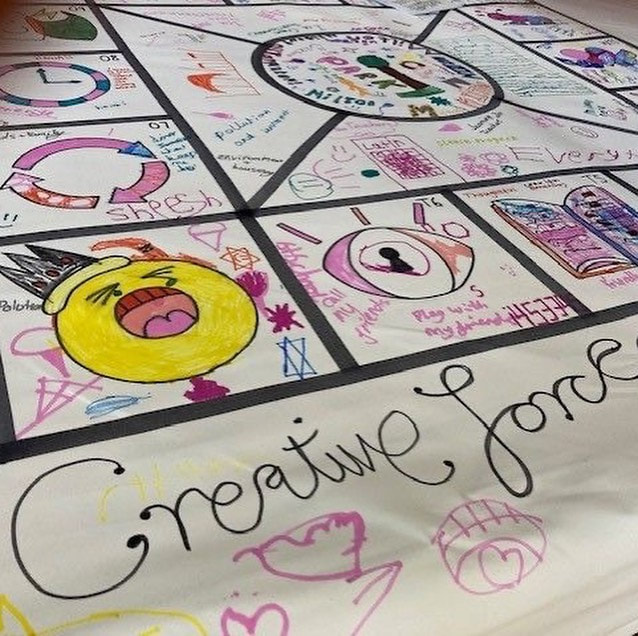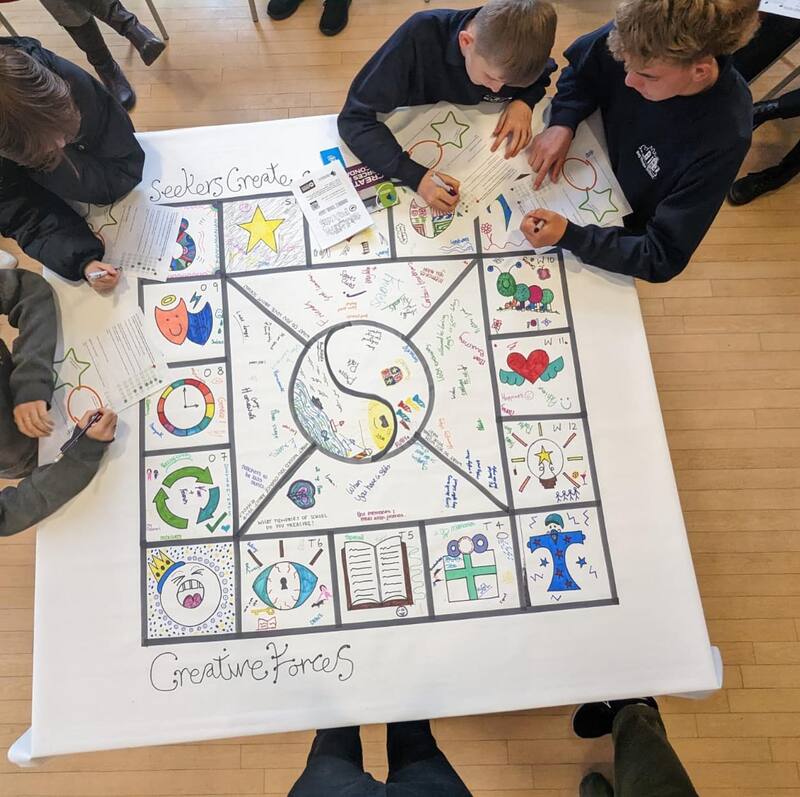Creative Forces is a project aimed at students from armed forces families and Creative Forces Day is a chance to explore university life and their identity as a service child.
As a creative engagement organisation Seekers were delighted to team up with University of Portsmouth to deliver the identity exploration element of the program to 14 schools, both primary and secondary. Over 100 children.
The Widening Participation Outreach team at the University of Portsmouth recently collaborated with Portsmouth-based social creative, Seekers Create, to provide opportunities for the exploration of student voice, as part of our university outreach activity.
The team had been looking for alternative and creative ways to capture participant feedback, and to embed evaluation within our activity rather than it feeling like a boring bolt on survey for the students we’re working with. We’d been tentatively dipping our toes into learning more about how student voice can directly inform future activity and teach us more about the lived experiences of those groups we seek to positively engage in university outreach.
The team had been looking for alternative and creative ways to capture participant feedback, and to embed evaluation within our activity rather than it feeling like a boring bolt on survey for the students we’re working with. We’d been tentatively dipping our toes into learning more about how student voice can directly inform future activity and teach us more about the lived experiences of those groups we seek to positively engage in university outreach.
Collaboration
We collaborated with Seekers Create as part of our Creative Forces events; university visit days for young people from Armed Forces families (service children). A little over half of state schools in England have at least 1 service pupil, and in Hampshire there are service pupils in 87% of schools, but they make up only a very small proportion of individual school cohorts (sometimes just 1 pupil). Compared to the general population, proportionally fewer service children progress to university.
Creative Forces events provide a taste of university through a campus visit and subject workshop. They also give the opportunity for service children from different schools to connect with one another, discuss and share their unique lived experiences and to explore the impacts of their experiences on school, peer relationships and education in general.
The brief to Seekers Create was to capture these valuable student insights in a way that was fun, engaging and explorative for the students. And that would help to share the voices of these young people to improve knowledge and understanding among their school staff, their peers and across the education sector, helping other universities to make the case for the inclusion of Access and Participation Plan targets relating to service children. It was important to take a strengths-based approach, exploring the unique skills and experiences of service children and not focussing on possible barriers to progression.
Creative Forces events provide a taste of university through a campus visit and subject workshop. They also give the opportunity for service children from different schools to connect with one another, discuss and share their unique lived experiences and to explore the impacts of their experiences on school, peer relationships and education in general.
The brief to Seekers Create was to capture these valuable student insights in a way that was fun, engaging and explorative for the students. And that would help to share the voices of these young people to improve knowledge and understanding among their school staff, their peers and across the education sector, helping other universities to make the case for the inclusion of Access and Participation Plan targets relating to service children. It was important to take a strengths-based approach, exploring the unique skills and experiences of service children and not focussing on possible barriers to progression.
Gamifying Student Voice
Seekers Create presented the students with a gamified S.W.OT analysis. A scavenger hunt-style trail to follow, answering reflective and explorative questions framed around their Strengths, Wishes, Obstacles and Treasures, and constructed from the outreach team’s broader outcomes framework, which focuses on attitudinal changes towards progression and higher education.
Students worked together as a team to follow the trail and then complete a giant doodle mural, translating their answers into doodles, sketches and scribbles, which they took back to school for display.
Students worked together as a team to follow the trail and then complete a giant doodle mural, translating their answers into doodles, sketches and scribbles, which they took back to school for display.
Impact
The honesty, breadth and depth of student insights gathered was profound. The willingness to engage in this form of explorative activity was surprising, and resulted in much richer qualitative data than surveys at previous Creative Forces events and a wealth of audio recordings that will be turned into a supporting resource for anyone who works with service children in an education setting.
Feedback from the participants on the game itself, was that they enjoyed being a part of the process and not just passive participants in someone else’s evaluation of them. We have since engaged a small number of the Creative Forces cohort again, in helping us expand and develop a Creative Forces programme in a process of co-design built directly upon their voices and experiences.
And of course, at an individual level, each school has a wall mural to display and spark conversation in school among friends, teachers, school staff and parents.
Feedback from the participants on the game itself, was that they enjoyed being a part of the process and not just passive participants in someone else’s evaluation of them. We have since engaged a small number of the Creative Forces cohort again, in helping us expand and develop a Creative Forces programme in a process of co-design built directly upon their voices and experiences.
And of course, at an individual level, each school has a wall mural to display and spark conversation in school among friends, teachers, school staff and parents.
Key takeaways for exploring student voice through university outreach:1. Identify partners for collaboration that share your valuesPartners that resonate on a personal level. If they resonate with you, they’ll probably resonate with your audiences too.
2. Loosen your grip on that project briefHaving a clear brief is important, but if you’re collaborating with someone because they’re creative, then let them be creative. When it comes to something as indefinable as student voice, the risk could be worth the reward.
3. Make qualitative data your friendAs outreach practitioners we feel a pressure to prove impact, and it is important, but we inevitably resort to quantifiable statistics to demonstrate the value of our work, because that’s the nature of the environment we’re working in.
But don’t be afraid of engaging in student voice activities because it won’t yield data that can be neatly packaged up using the Likert Scale.
Some of the ways that we’ll be using the qualitative data to share the impact of this project include:
2. Loosen your grip on that project briefHaving a clear brief is important, but if you’re collaborating with someone because they’re creative, then let them be creative. When it comes to something as indefinable as student voice, the risk could be worth the reward.
3. Make qualitative data your friendAs outreach practitioners we feel a pressure to prove impact, and it is important, but we inevitably resort to quantifiable statistics to demonstrate the value of our work, because that’s the nature of the environment we’re working in.
But don’t be afraid of engaging in student voice activities because it won’t yield data that can be neatly packaged up using the Likert Scale.
Some of the ways that we’ll be using the qualitative data to share the impact of this project include:
- Podcasts using the voice of service children
- Blogs (including this one!)
- The displaying of doodle murals in the participating schools or their community spaces
- Themes from the student voice data to inform focus groups and co-design groups for future development of service child outreach
- Evidence to inform future Access and Participation Plan targets
- Within professional CPD – check out our Thriving Lives Webinar programme for 2023-24.
In December 2023 Seekers Create and University of Portsmouth attended and presented at the Service Children's Progression Alliance (SCiP) Conference with a sold-out audience of 100 allies in Birmingham for a day of learning. Expertly chaired by Lizzie Rodulson, herself a Service child and current SCiP Alliance Board member.
Our workshop ‘Identity Matters’ focused on understanding and supporting service children. Using Seekers creative methods we delved into the unique challenges and experiences faced by service children due to the nature of their parents' occupations.
Below are some of our Key findings:
1.Distinct Challenges
Service children face unique hurdles due to military life—frequent relocations, parental deployment, and related uncertainties disrupt their experiences.
2.Adaptability and Necessity of Resilience
Service children are viewed as adaptable to change, yet their resilience is often a necessity, forced by significant family and environmental upheavals.
3.Specialised Support Needs
Service children demand specialised support in education and communities. Recognizing their unique circumstances is crucial, requiring tailored support for emotional, social, and educational well-being.
4.Awareness Gap and Identification Struggles
Identifying service children in schools and communities is challenging, leading to a lack of awareness and hindering the provision of essential support and resources.
5.Community and Peer Support Vital
Emphasising community support, fostering understanding, and acceptance is vital for service children. Peer support acts as a valuable resource, reducing isolation through shared experiences.
6.Educational Flexibility
Educational adjustments must accommodate the unique lifestyle of service children, necessitating flexible school policies for their frequent relocations and parental deployments.
7.Empowerment Focus
Empowering service children involves giving them a voice, engaging in activities for expressing experiences, and fostering a sense of control and agency to cope with their circumstances.
8.Creative Expression Significance
Recognising the effectiveness of creative activities like art and doodling, these non-verbal tools aid service children in expressing and processing their feelings, especially beneficial for those struggling to articulate verbally.
The collaboration between Seekers Create, the University of Portsmouth, and the SCiP Alliance exemplifies the power of bringing together diverse perspectives and expertise to address complex societal challenges. Moving forward, it is our collective responsibility to build on these insights and continue advocating for the well-being and inclusivity of service children in all aspects of their lives.
Through sustained efforts and collaborative initiatives, we can create a future where service children can share their challenges to enable them to thrive in environments that recognise, appreciate, and cater to their unique and changing needs.
Our workshop ‘Identity Matters’ focused on understanding and supporting service children. Using Seekers creative methods we delved into the unique challenges and experiences faced by service children due to the nature of their parents' occupations.
Below are some of our Key findings:
1.Distinct Challenges
Service children face unique hurdles due to military life—frequent relocations, parental deployment, and related uncertainties disrupt their experiences.
2.Adaptability and Necessity of Resilience
Service children are viewed as adaptable to change, yet their resilience is often a necessity, forced by significant family and environmental upheavals.
3.Specialised Support Needs
Service children demand specialised support in education and communities. Recognizing their unique circumstances is crucial, requiring tailored support for emotional, social, and educational well-being.
4.Awareness Gap and Identification Struggles
Identifying service children in schools and communities is challenging, leading to a lack of awareness and hindering the provision of essential support and resources.
5.Community and Peer Support Vital
Emphasising community support, fostering understanding, and acceptance is vital for service children. Peer support acts as a valuable resource, reducing isolation through shared experiences.
6.Educational Flexibility
Educational adjustments must accommodate the unique lifestyle of service children, necessitating flexible school policies for their frequent relocations and parental deployments.
7.Empowerment Focus
Empowering service children involves giving them a voice, engaging in activities for expressing experiences, and fostering a sense of control and agency to cope with their circumstances.
8.Creative Expression Significance
Recognising the effectiveness of creative activities like art and doodling, these non-verbal tools aid service children in expressing and processing their feelings, especially beneficial for those struggling to articulate verbally.
The collaboration between Seekers Create, the University of Portsmouth, and the SCiP Alliance exemplifies the power of bringing together diverse perspectives and expertise to address complex societal challenges. Moving forward, it is our collective responsibility to build on these insights and continue advocating for the well-being and inclusivity of service children in all aspects of their lives.
Through sustained efforts and collaborative initiatives, we can create a future where service children can share their challenges to enable them to thrive in environments that recognise, appreciate, and cater to their unique and changing needs.








